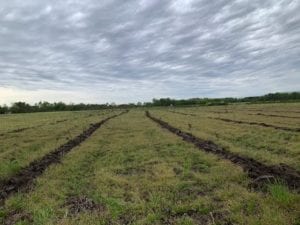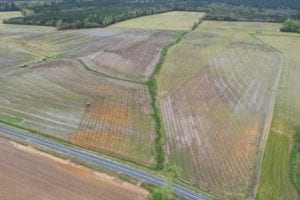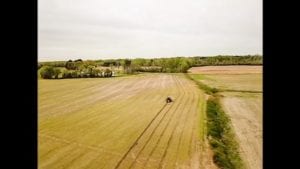
Building Kittrell Hill Mitigation Site
When planting a mitigation site, the timing is very important. There is a planting season during which you will have the highest survival rate for the plants and trees that you need to plant to build a mitigation site. Although you can plant outside of that ideal window, you will be putting your trees and plants at a higher risk of dying by doing so. We recently planted a forested buffer site in the Farmville area that gained it’s final approvals and had the weather and conditions all work out on the back end of the ideal planting window. We had some challenging weather to deal with in the weeks before but were lucky to find some excellent  conditions just when we needed them. The first day we had weather that was in the high 70’s and was by any reasonable standard a beautiful spring day. The conditions of the soil were a little dry, and that combined with the wind and sun made it important for us to make sure our trees were planted as soon as possible to protect them from drying out. For this site, we used a machine being pulled behind a tractor that scoured the earth with a large ripping blade and planter that then pushed the soil back together after we dropped in the appropriate tree in the open soil. This method was great for helping us to quickly make uniform rows with uniform spacing while also varying the different species. The downside was that there was a potential for the tree’s roots to be floating in a pocket of air depending on the soil conditions without the roots being fully engaged with the surrounding soil. If this happened, the soil has a higher potential to dry out, and the trees have the potential to have their roots dry out as well. To resolve this potential problem, we needed to follow behind the tractor with a shovel to aid in any repairs and ensure that the roots were fully engaged with the surrounding soil by stepping on either side of the newly planted trees. These two simple steps allowed us to ensure that the trees avoided being unnecessarily distressed or dried out and were seated securely in the soil. While this method was straight forward and simple to execute, we were planting almost 14,000 trees, so we were going to need to make a lot of steps.
conditions just when we needed them. The first day we had weather that was in the high 70’s and was by any reasonable standard a beautiful spring day. The conditions of the soil were a little dry, and that combined with the wind and sun made it important for us to make sure our trees were planted as soon as possible to protect them from drying out. For this site, we used a machine being pulled behind a tractor that scoured the earth with a large ripping blade and planter that then pushed the soil back together after we dropped in the appropriate tree in the open soil. This method was great for helping us to quickly make uniform rows with uniform spacing while also varying the different species. The downside was that there was a potential for the tree’s roots to be floating in a pocket of air depending on the soil conditions without the roots being fully engaged with the surrounding soil. If this happened, the soil has a higher potential to dry out, and the trees have the potential to have their roots dry out as well. To resolve this potential problem, we needed to follow behind the tractor with a shovel to aid in any repairs and ensure that the roots were fully engaged with the surrounding soil by stepping on either side of the newly planted trees. These two simple steps allowed us to ensure that the trees avoided being unnecessarily distressed or dried out and were seated securely in the soil. While this method was straight forward and simple to execute, we were planting almost 14,000 trees, so we were going to need to make a lot of steps.

While the weather on day one was enjoyable, the forecast for day two was much colder, and we were expecting rain in the afternoon or evening. Having rain come through while planting is a beautiful thing, but it does put you under the gun to get everything in the ground as fast as possible before it comes. We had a two to three-day estimate on completing the planting of this site, so when rain was expected on day two, we were in a rush to get as much done as possible before then so that the rain could help settle all of our 14,000 trees into place. We worked hard and were able to plant about three-quarters of the site before the rain came in on day 2. The rain went into the night, and there was a substantial amount of rainfall in the end. On day three, we arrived at the site to see standing water on most of the rows with temperatures about 30 degrees colder than day one and howling winds. Luckily we had almost all of our hand planting along the banks and in difficult areas for the tractor to reach completed and were working in a single isolated section of the site to finish. The wet soil made setting the trees in place a much easier process even though the ground was soft and more difficult to walk through. We were able to finish planting our trees without any issue and completed the site on day three.
The conditions on each day were very different and each presented different benefits and different challenges. The first day’s conditions were the most pleasant to work in, although they presented the higher risk conditions for the trees drying out due to the sunlight, wind, and dryer soil. The second day we had better overcast cooler conditions but had the rush of an afternoon rain pushing us to work as fast as we could. And lastly, the third day, the conditions were fairly miserable with the drop in temperature, consistently strong wind gusts, and muddy soil to walk through but were really the best conditions for planting our trees of all three days. The week before the weather was in the 80’s most of the week and very dry, so we really did get lucky with the timing of when we were able to put the trees in the ground to give this buffer mitigation site the best chance at a high survival rate.
 The conditions can always play a very significant factor in planting a successful mitigation site. You want to give yourself a proper window of time in an ideal situation to allow some flexibility as to when you plant for that reason. In this circumstance, we had a limited amount of time left in the planting season to work with, so we had to be ready to jump into action when the time was right. We planned for it, we were prepared, and in the end, we were lucky enough to have the weather work out almost perfectly in our favor to give the trees we planted the best chance at survival in their new homes.
The conditions can always play a very significant factor in planting a successful mitigation site. You want to give yourself a proper window of time in an ideal situation to allow some flexibility as to when you plant for that reason. In this circumstance, we had a limited amount of time left in the planting season to work with, so we had to be ready to jump into action when the time was right. We planned for it, we were prepared, and in the end, we were lucky enough to have the weather work out almost perfectly in our favor to give the trees we planted the best chance at survival in their new homes.